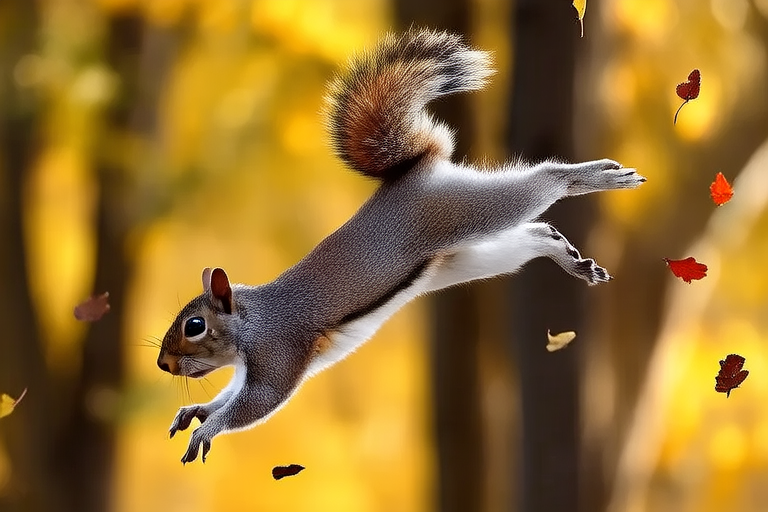
The Intriguing World of Squirrels
Squirrels, those nimble and ubiquitous creatures, have long been familiar to us through their apparent fondness for nuts. However, there is much more to these small mammals than meets the eye. From their unique behaviors and habitats to their crucial role in ecosystems, squirrels offer a fascinating glimpse into the natural world. Let’s delve deeper into the lives of these often-overlooked animals.
Unique Behaviors and Adaptations
Squirrels exhibit a range of fascinating behaviors that go beyond simply gathering nuts. One such behavior is their ability to communicate effectively. They use a variety of vocalizations, body postures, and tail movements to convey messages to other squirrels. For instance, a flicking tail can signal danger, while chattering might indicate territorial disputes or mating readiness.
Another remarkable adaptation is their incredible memory. Many species of squirrels are known for their ability to remember the locations of thousands of buried nuts. This skill, essential for survival, allows them to retrieve food during lean times. The gray squirrel, for example, can recall the exact spot where it stashed a nut months earlier, even after covering it with leaves or snow.
Habitats and Diverse Species
Squirrels are found in various habitats around the world, from dense forests to urban parks. They thrive in diverse environments, including deciduous and coniferous forests, grasslands, and even deserts. Each habitat presents its own challenges and opportunities, shaping the squirrels’ behavior and physiology.
There are over 200 species of squirrels worldwide, ranging from the tiny African pygmy squirrel, which weighs less than an ounce, to the large Indian giant squirrel, measuring up to three feet in length. These varied species have adapted to their specific environments, from the high-altitude red squirrels of the Himalayas to the ground-dwelling prairie dogs of North America.
Social Structures and Communication
Contrary to popular belief, many squirrel species are not solitary animals. While some species, like the red squirrel, tend to be solitary, others, such as the eastern gray squirrel, live in complex social groups. These groups often consist of multiple generations living together, sharing responsibilities like raising young and defending territory.
Communication among squirrels is a vital aspect of their social structure. Besides vocalizations, they also use scent marking to establish territories and attract mates. Squirrels have scent glands on their cheeks, which they rub against objects to leave their mark. This method helps in maintaining social bonds and avoiding conflicts within the group.
Survival Strategies
Squirrels employ a variety of strategies to ensure their survival. One of the most effective is their ability to adapt to changing environments. In urban areas, for instance, squirrels have learned to navigate human-made structures, using fences, trees, and buildings to move around safely. They have also become adept at scavenging food from human sources, making them highly adaptable to city life.
In addition to their physical adaptations, squirrels have developed sophisticated defense mechanisms. When threatened, they may perform a “tail-flagging” display, where they wave their tails rapidly to intimidate predators. This behavior is particularly common in ground squirrels, which face a higher risk of predation compared to tree-dwelling species.
Role in Ecosystems
Squirrels play a crucial role in maintaining the balance of their ecosystems. As seed dispersers, they help regenerate forests by burying nuts and seeds, which they sometimes forget to retrieve. These forgotten seeds eventually grow into new trees, contributing to forest regeneration and biodiversity.
Moreover, squirrels serve as prey for numerous predators, including birds of prey, foxes, and snakes. Their abundance provides a valuable food source for these predators, supporting the overall health of the ecosystem. In turn, squirrels have evolved various defensive strategies to evade predation, such as hiding in trees and using alarm calls to warn others of danger.
Seasonal Activities
The activities of squirrels vary throughout the year, depending on factors like temperature, food availability, and breeding cycles. During spring and summer, squirrels are busy gathering and storing food for the colder months ahead. They also engage in territorial disputes and courtship rituals during this time.
In autumn, squirrels enter a period of hyperphagia, where they consume large amounts of food to build up fat reserves for winter. This period of intense eating is followed by hibernation in some species, such as the thirteen-lined ground squirrel. Other species, like the eastern gray squirrel, remain active throughout the winter, relying on stored food and their ability to find food under the snow.
Interactions with Urban Environments
Squirrels have adapted remarkably well to urban environments, thriving in cities and towns across the globe. In these settings, they have become familiar sights, scampering along sidewalks and climbing trees in parks. Their presence in urban areas has both positive and negative impacts.
On one hand, squirrels provide entertainment and a connection to nature for city dwellers. They also help control insect populations and contribute to the pollination of plants. On the other hand, squirrels can cause damage to gardens and infrastructure, such as electrical lines. Managing squirrel populations in urban areas requires a delicate balance between conservation and control.
Conclusion
The world of squirrels is far more intricate and fascinating than commonly perceived. From their impressive memory and communication skills to their crucial role in ecosystems, these small mammals offer a wealth of knowledge and inspiration. By understanding and appreciating the complexities of squirrel life, we gain a deeper respect for the natural world and our place within it.






